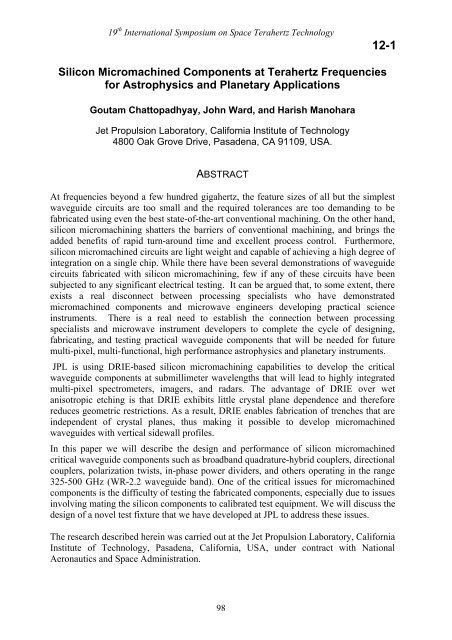Program and Abstract Book - SRON
Program and Abstract Book - SRON
Program and Abstract Book - SRON
Create successful ePaper yourself
Turn your PDF publications into a flip-book with our unique Google optimized e-Paper software.
19 th International Symposium on Space Terahertz Technology<br />
12-1<br />
Silicon Micromachined Components at Terahertz Frequencies<br />
for Astrophysics <strong>and</strong> Planetary Applications<br />
Goutam Chattopadhyay, John Ward, <strong>and</strong> Harish Manohara<br />
Jet Propulsion Laboratory, California Institute of Technology<br />
4800 Oak Grove Drive, Pasadena, CA 91109, USA.<br />
ABSTRACT<br />
At frequencies beyond a few hundred gigahertz, the feature sizes of all but the simplest<br />
waveguide circuits are too small <strong>and</strong> the required tolerances are too dem<strong>and</strong>ing to be<br />
fabricated using even the best state-of-the-art conventional machining. On the other h<strong>and</strong>,<br />
silicon micromachining shatters the barriers of conventional machining, <strong>and</strong> brings the<br />
added benefits of rapid turn-around time <strong>and</strong> excellent process control. Furthermore,<br />
silicon micromachined circuits are light weight <strong>and</strong> capable of achieving a high degree of<br />
integration on a single chip. While there have been several demonstrations of waveguide<br />
circuits fabricated with silicon micromachining, few if any of these circuits have been<br />
subjected to any significant electrical testing. It can be argued that, to some extent, there<br />
exists a real disconnect between processing specialists who have demonstrated<br />
micromachined components <strong>and</strong> microwave engineers developing practical science<br />
instruments. There is a real need to establish the connection between processing<br />
specialists <strong>and</strong> microwave instrument developers to complete the cycle of designing,<br />
fabricating, <strong>and</strong> testing practical waveguide components that will be needed for future<br />
multi-pixel, multi-functional, high performance astrophysics <strong>and</strong> planetary instruments.<br />
JPL is using DRIE-based silicon micromachining capabilities to develop the critical<br />
waveguide components at submillimeter wavelengths that will lead to highly integrated<br />
multi-pixel spectrometers, imagers, <strong>and</strong> radars. The advantage of DRIE over wet<br />
anisotropic etching is that DRIE exhibits little crystal plane dependence <strong>and</strong> therefore<br />
reduces geometric restrictions. As a result, DRIE enables fabrication of trenches that are<br />
independent of crystal planes, thus making it possible to develop micromachined<br />
waveguides with vertical sidewall profiles.<br />
In this paper we will describe the design <strong>and</strong> performance of silicon micromachined<br />
critical waveguide components such as broadb<strong>and</strong> quadrature-hybrid couplers, directional<br />
couplers, polarization twists, in-phase power dividers, <strong>and</strong> others operating in the range<br />
325-500 GHz (WR-2.2 waveguide b<strong>and</strong>). One of the critical issues for micromachined<br />
components is the difficulty of testing the fabricated components, especially due to issues<br />
involving mating the silicon components to calibrated test equipment. We will discuss the<br />
design of a novel test fixture that we have developed at JPL to address these issues.<br />
The research described herein was carried out at the Jet Propulsion Laboratory, California<br />
Institute of Technology, Pasadena, California, USA, under contract with National<br />
Aeronautics <strong>and</strong> Space Administration.<br />
98
















